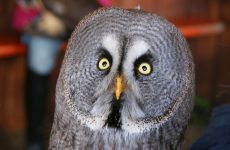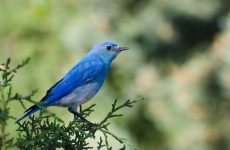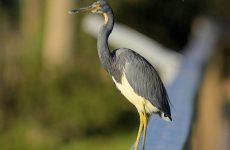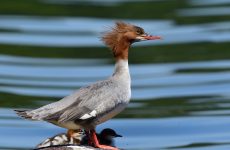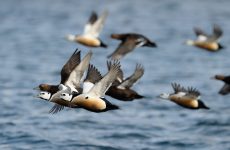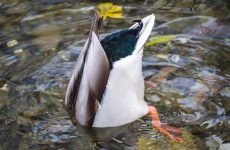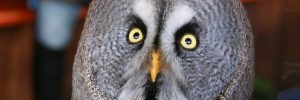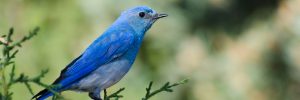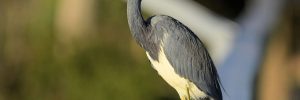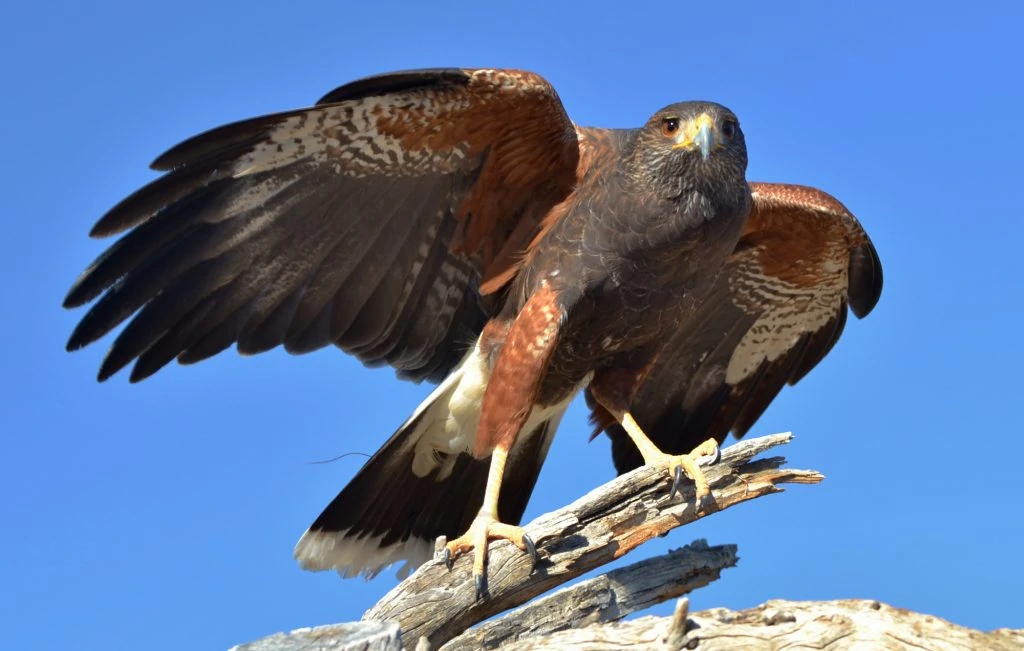
Hawks are birds of prey and hunt and eat birds and small mammals, snakes, and frogs. They can see ultraviolet light, which helps them hunt down their prey.
There are 18 species of hawks recognized on state checklists as regularly occurring in the United States and Canada, and an additional one species are considered rare or accidental. Still, I have included this addition due to the volume of sightings.
To find Hawks head to woodland for the smaller hawks such as the Sharp-shinned Hawk and Cooper’s Hawk or open grassland, marshes, or high ridges for the larger species.
This guide will help you identify the species of hawks in the United States and Canada according to avibase, and ordered by the number of sighting recorded on ebird. Some of these birds migrate, and some remain all year and this information is included for each species.
The most common hawk in both summer and winter is the Red-tailed Hawk.
There are 19 species of Hawk in North America:
- Red-tailed Hawk
- Red-shouldered Hawk
- Cooper’s Hawk
- Northern Harrier
- Sharp-shinned Hawk
- Broad-winged Hawk
- Swainson’s Hawk
- Rough-legged Hawk
- Ferruginous Hawk
- Harris Hawk
- Gray hawk
- Northern Goshawk
- White-tailed Hawk
- Zone-tailed hawk
- Short-tailed Hawk
- Common Black Hawk
- Great black Hawk
- Roadside Hawk
- Crane Hawk
The 19 Species of Hawk in the United States:
1. Red-tailed Hawk
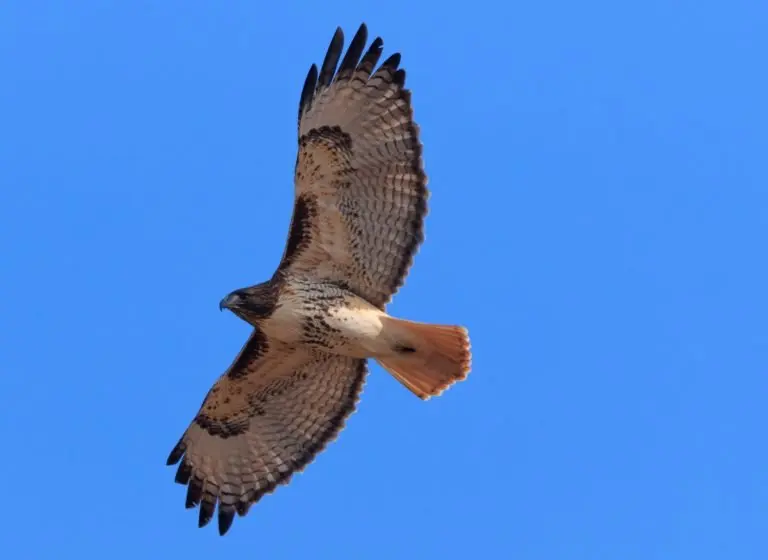
As their name suggests, Red-tailed Hawks have a distinctive short, wide red tail. They are large, with broad, rounded wings. Most Red-tailed Hawks are brown on the back and pale underneath.
They are also the easiest to spot, often on long car journeys, as they circle slowly over open fields looking for prey such as small mammals, birds, and reptiles. You can also see them perched on telephone poles.
Male
- Length: 17.7-22.1 in (45-56 cm)
- Weight: 24.3-45.9 oz (690-1300 g)
- Wingspan: 44.9-52.4 in (114-133 cm)
Female
- Length: 19.7-25.6 in (50-65 cm)
- Weight: 31.8-51.5 oz (900-1460 g)
- Wingspan: 44.9-52.4 in (114-133 cm)
Red-tailed Hawk Call:
The high-pitched descending raspy-screech sound of the Red-tailed Hawk is often used in movies for all birds of prey.
Red-tailed Hawks remain resident in the US and Mexico, but those birds in Alaska, Canada, and the northern Great Plains fly south for winter.
Nests are high in tall trees, cliff ledges, and sometimes on tall buildings or towers. They lay 2-3 whitish, brown-spotted eggs.
2. Red-shouldered Hawk
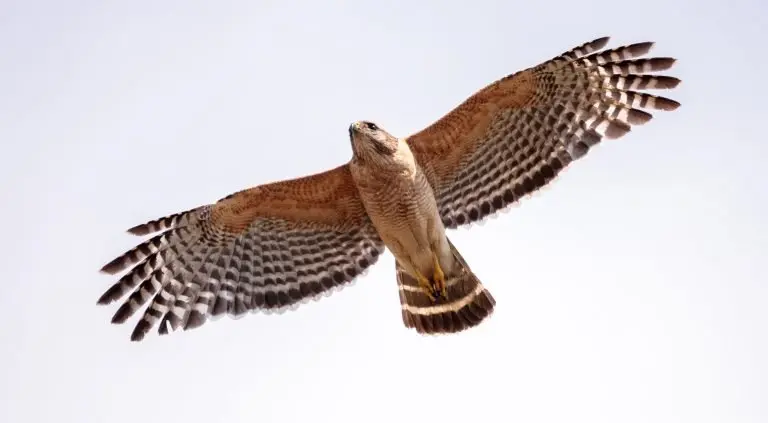
Red-shouldered Hawks are distinctly marked, with dark and white checkered wings and reddish barring on the breast. They are medium-sized, between the size of a crow and a swan with a strongly banded tail. They make a loud cack-cack-cack-cack call.
- Length: 16.9-24.0 in (43-61 cm)
- Weight: 17.1-27.3 oz (486-774 g)
- Wingspan: 37.0-43.7 in (94-111 cm)
Red-shouldered Hawk Call:
Red-shouldered Hawks are resident in eastern states, but those in the Northeast may migrate further south for winter. These hawks are also resident on the West Coast.
They tend to be seen near wet forests hunting along a stream or pond. Their prey is mammals and frogs or snakes.
Nests are often reused each year in a broad-leaved tree near water. They lay 2-5 white or bluish eggs.
3. Cooper’s Hawk
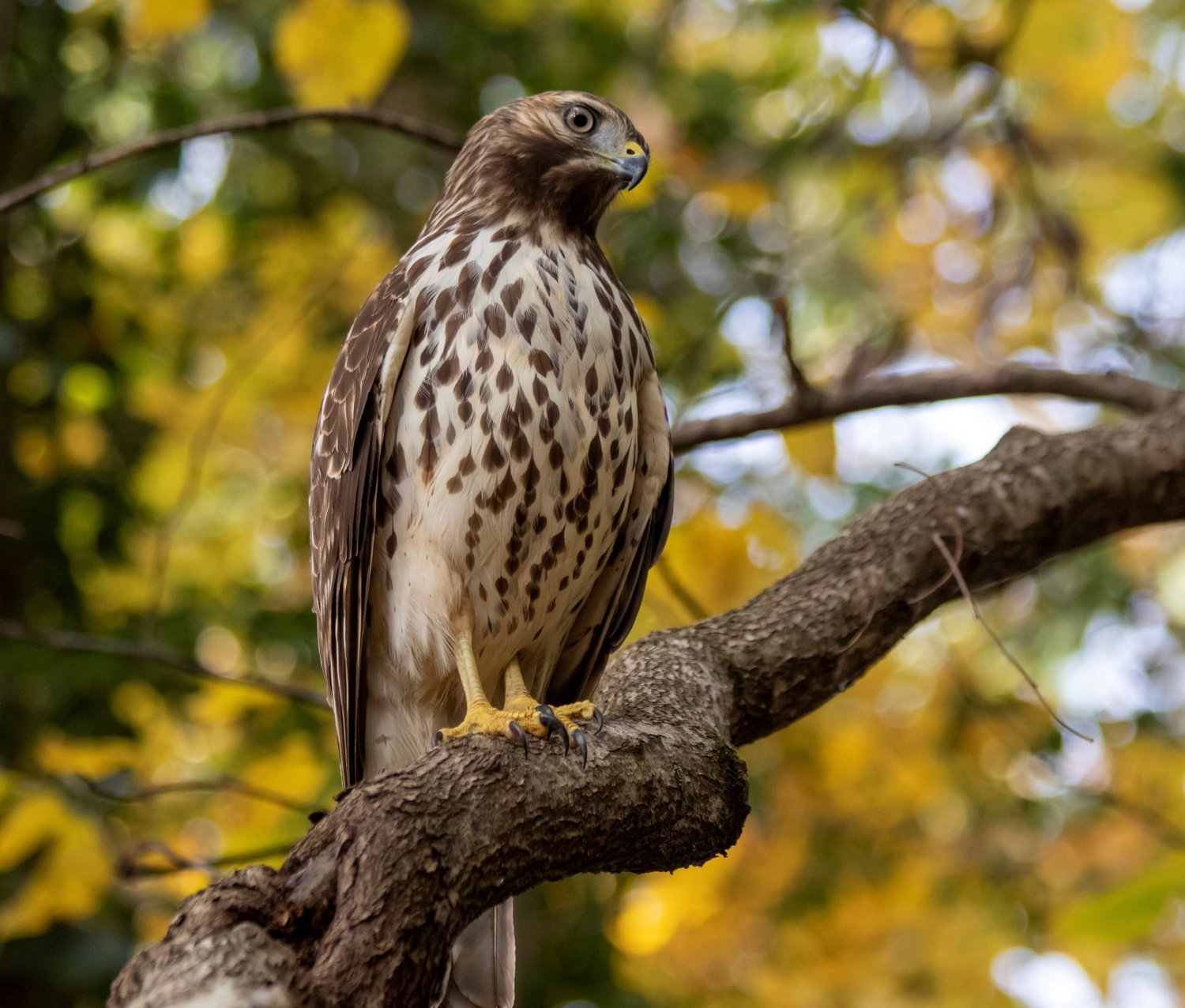
The Cooper’s Hawk looks very similar to the Sharp-shinned Hawk but is bigger at about the size of a crow. They can be hard to identify between them as they have the same blue-gray back and red-orange breast and also with dark bands on the tail.
They have a larger head that projects well beyond the wings, unlike the Sharp-shinned Hawk.
Male
- Length: 14.6-15.3 in (37-39 cm)
- Weight: 7.8-14.5 oz (220-410 g)
- Wingspan: 24.4-35.4 in (62-90 cm)
Female
- Length: 16.5-17.7 in (42-45 cm)
- Weight: 11.6-24.0 oz (330-680 g)
- Wingspan: 29.5-35.4 in (75-90 cm)
Cooper’s Hawks remain resident over most of the US, but some in the north of the range, including Canada, migrate south for the winter down as far as Mexico and Honduras.
Look out for them at the edge of forests, but they can also be seen at feeders looking for an easy meal.
They feed on medium-sized birds and small mammals and nest in tall trees, often on top of an old nest of a large bird or clump of mistletoe. They lay 2-6 pale blue to bluish-white eggs.
4. Northern Harrier
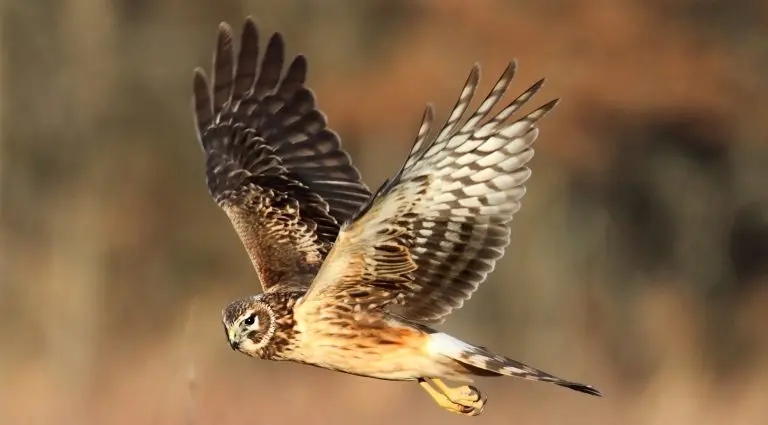
Northern Harriers are slender with long broad wings and are between the size of a crow and a goose. They often fly with the tips of their wings higher than their bodies in a v-shape.
Females are brown, and males are gray above and white below, and they have a white rump patch.
- Length: 18.1-19.7 in (46-50 cm)
- Weight: 10.6-26.5 oz (300-750 g)
- Wingspan: 40.2-46.5 in (102-118 cm)
Northern Harriers that breed in Alaska, Canada, the northern Great Plains, and the Northeast before migrating south for the winter to southern states, Mexico and Central America. Those in the middle of the range remain all year.
This slim, longed-tailed hawk can be seen gliding low over grassland or marshes.
Northern Harriers mostly eat small mammals and small birds. They nest on the ground in dense vegetation such as reeds, willows, or brushtails. They lay 4-5 dull white eggs.
5. Sharp-shinned Hawk
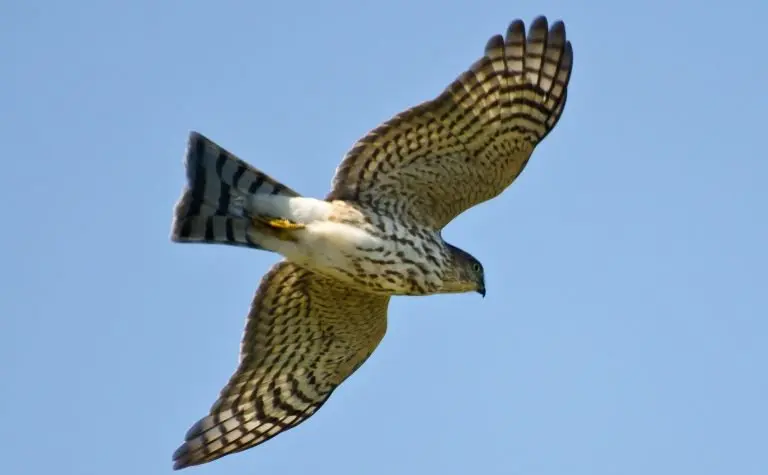
Adult Sharp-shinned Hawks are small hawks with blue-gray across the back and red-orange breasts. They have dark bands across their tails.
The females are a third larger than the male. They have long square-ended tails, short rounded wings, and small heads.
- Length: 9.4-13.4 in (24-34 cm)
- Weight: 3.1-7.7 oz (87-218 g)
- Wingspan: 16.9-22.1 in (43-56 cm)
Sharp-shined Hawks that breed in Canada and some northern states migrate south. Those birds in the Appalachians and Western Mountains may remain all year.
Sharp-shined Hawks are very secretive but can be seen as they fly across open areas at the edges of forests. They are very agile and can speed through dense woods to catch their prey in flight, usually songbirds.
They can sometimes be seen near feeders catching small birds, but if you have problems with them in your backyard, remove the feeder for a few weeks.
Sharp-shinned Hawks pluck their prey on a stump or low branch before eating it. They usually eat songbirds about the size of a robin.
Nests of the Sharp-shinned Hawk are often in conifer trees in dense cover, usually towards the top of tall trees. The nest is quite large, being 1-2 feet in diameter and 4-6 inches deep. They lay 3-8 white or pale-blue mottled eggs.
6. Broad-winged Hawk
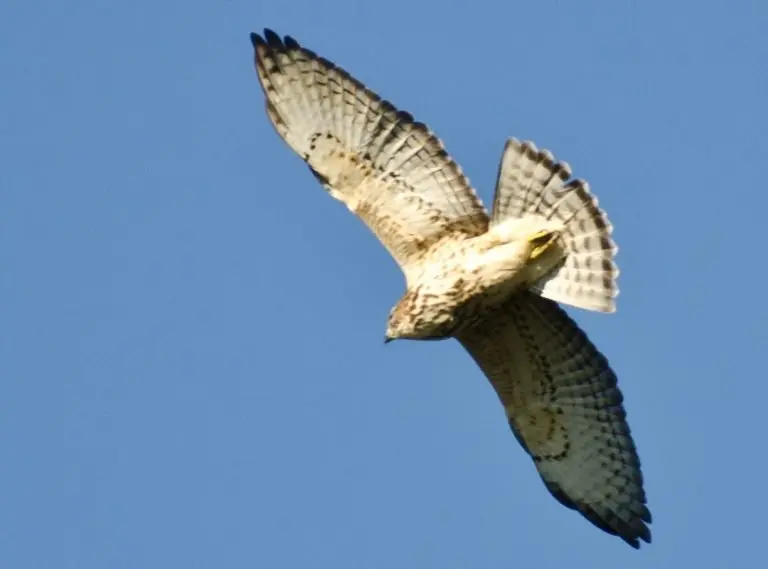
The Broad-winged Hawk is a compact, stocky bird between the size of a crow and goose. They have reddish-brown heads, barred breasts, and narrowly banded short square tails.
- Length: 13.4-17.3 in (34-44 cm)
- Weight: 9.3-19.8 oz (265-560 g)
- Wingspan: 31.9-39.4 in (81-100 cm)
Broad-winged Hawks breed in the Eastern US and Canada before migrating in large numbers to Central, and South America in a swirling flock called a kettle. As a result, the migration in the fall is often the best chance to see them.
Hunting from a perch, often on the edge of woods or water, these hawks eat small mammals, frogs, snakes, and even young turtles.
The Broad-winged Hawk often reuses the nest of another animal, such as a crow or squirrel, and lays 2-3 whitish eggs.
7. Rough-legged Hawk
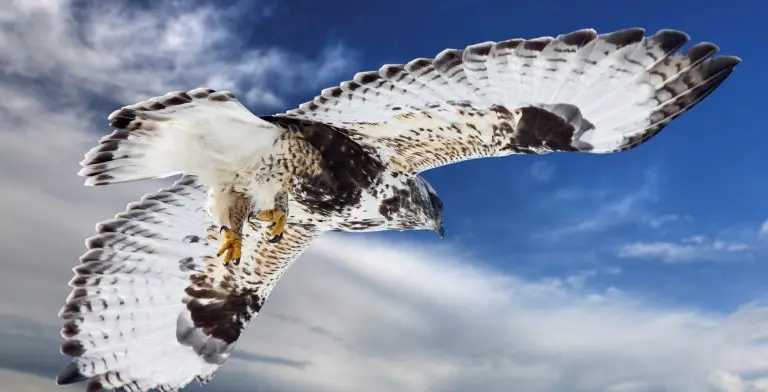
The feathered legs give the Rough-legged Hawks their name and help to keep them warm in the arctic. They are fairly large hawks, between the size of a crow and a goose.
This predominantly dark-drown species occurs in light and dark forms, with dark patches at the bend of the wing, end of their tails, and across the belly. They have broad wings that are relatively long and narrow compared to other hawks.
- Length: 18.5-20.5 in (47-52 cm)
- Weight: 25.2-49.4 oz (715-1400 g)
- Wingspan: 52.0-54.3 in (132-138 cm)
Rough-legged Hawks breed in Alaska and northern Canada before migrating to the US for winter. They are usually sighted hovering over marshes and open fields or perched on a pole.
Lemmings and voles provide most of the prey for Rough-legged Hawks. Voles, mice, ground squirrels, and other small mammals provide winter prey in states such as West Virginia. Nests are usually on a high cliff ledge, and they lay 3-5 pale bluish-white eggs.
8. Swainson’s Hawk
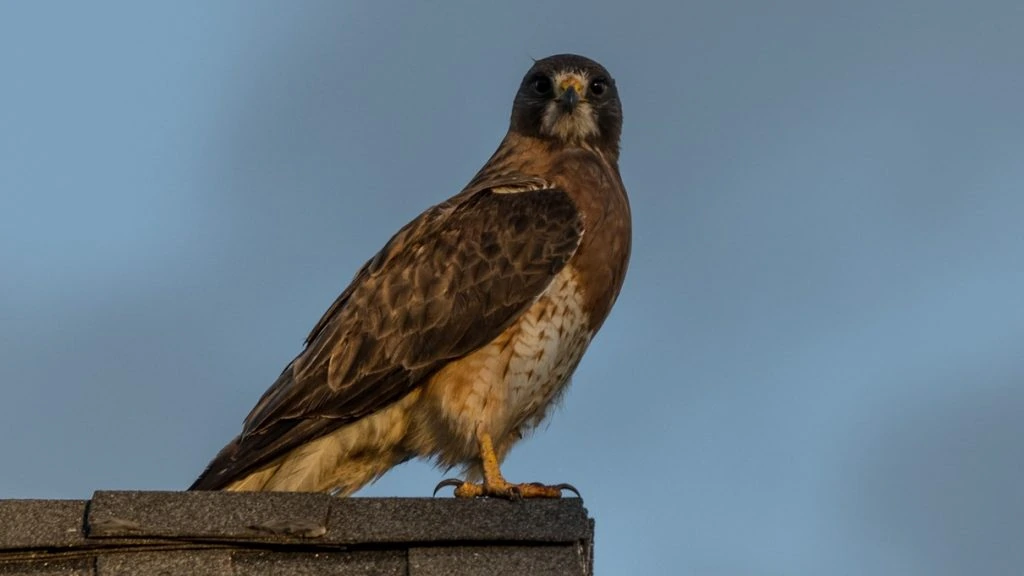
Swainson’s Hawks are long-winged hawks with short tails and pointed wingtips. They are usually brown or gray mottled on the back and with lighter bellies and brown or red chests.
When in flight, you can see the contrast between the black flight feathers on the lower edges of the wings and tips and the white upper part of the wing (called the linings).
- Length: 18.9-22.1 in (48-56 cm)
- Weight: 24.4-48.2 oz (693-1367 g)
Swainson’s Hawks can be found in open country in the West and over the Great Plains in the summer before heading to South America for winter in large flocks, reaching into the thousands. They breed as far as British Columbia and Alaska and in the West from the Pacific to the Midwest.
May and September are the best times to see these hawks as they migrate long distances and are famous for providing spectacular displays in the tens of thousands of birds during the day.
Swainson’s Hawks hunt for rodents by perching on any high points, such as utility poles or fences, making them easier to spot in the relatively flat lands where they hunt. If no high points are available, they may be found on the ground in grassland and fields, hunting for insects.
They may also eat Burrowing Owls in areas where they are abundant, but they are not fussy and eat anything from snakes and lizards to bats, mice, and rabbits or crickets and dragonflies.
There are not many nest sites in the open country for Swainson’s Hawks, so they use any trees near fields or low mesquite bushes and power poles. The nests are a large collection of twigs and sticks and can be up to 2 feet wide and up to a foot high. The inside of the nest is lined with softer material, such as dung, bark, wool, and grass.
9. Ferruginous Hawk
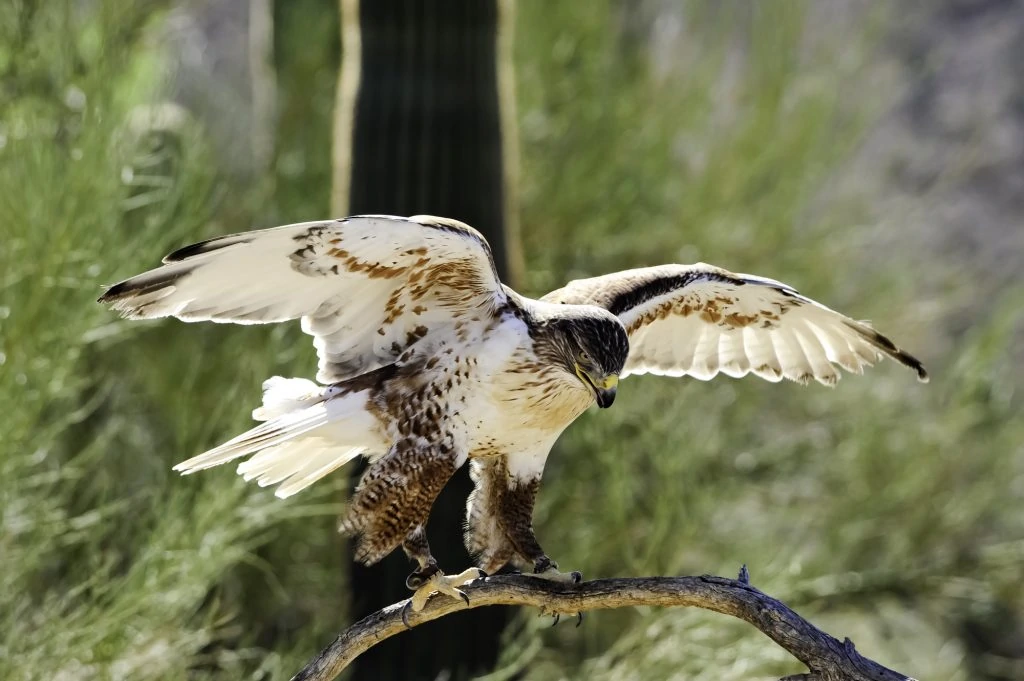
Ferruginous Hawks are the largest hawks in North America. They have large heads and long wings. To make identification harder, they come in a light and a dark morph, which can vary quite considerably in the color pattern.
The more common light morph Ferruginous Hawks are white underneath on the wings, belly, and head. Their backs and the upper side of the wings are a rusty brown, and they have darker legs. Immature light morphs have more brown spotting on the belly and legs.
Dark morphs are much rarer, and they have brown bellies and under the wings, except for white flight feathers on the wingtips and tail.
- Length: 22.1-27.2 in (56-69 cm)
- Weight: 34.5-73.2 oz (977-2074 g)
- Wingspan: 52.4-55.9 in (133-142 cm)
Ferruginous Hawks are another species of hawk that lives in the open country of the West. They breed as far north as Southern Canada and down to Nevada and Utah. In winter, they move short distances to Southern States and Mexico. Some birds may remain residents all year in the middle of their range.
You can spot Ferruginous Hawks in grassland and shrublands in the low country. They do not cross the Rockies, even when migrating. Small mammals make up the majority of their diet, and depending on what is available, they eat jackrabbits and cottontail rabbits in the West and ground squirrels and prairie dogs in the East.
They are daytime hunters and hunt both on the wing and by perching or even hunting on the ground.
Their nests are very large and can measure 3 feet high and 3 feet across, and they can lay up to 8 eggs.
10. Harris Hawk

Harris Hawks are unusual in both their coloring and habits. Their dark brown and reddish tones with flashes of white stand out against the arid environments they inhabit.
They are medium-sized hawks with broad rounded wings and long tails. Their tails are often fanned out and have distinctive dark and light bands. Females can be twice as heavy as males but usually around 30-40% heavier.
- Length: 18.1-23.2 in (46-59 cm)
- Weight: 18.2-31.0 oz (515-880 g)
- Wingspan: 40.5-46.9 in (103-119 cm)
They are unusual birds of prey in that they often live in social groups of about six or seven birds. They cooperate in hunting and helping breeding pairs in the group.
Due to their intelligence, they are prized in falconry as they are easy to train.
Harris Hawks can be found in arid Southern States, Mexico, and down through South America.
Birds, mammals, and insects or lizards make up the main diet, but they can also catch jackrabbits or larger birds such as small wild turkeys when they hunt in groups.
11. Gray hawk
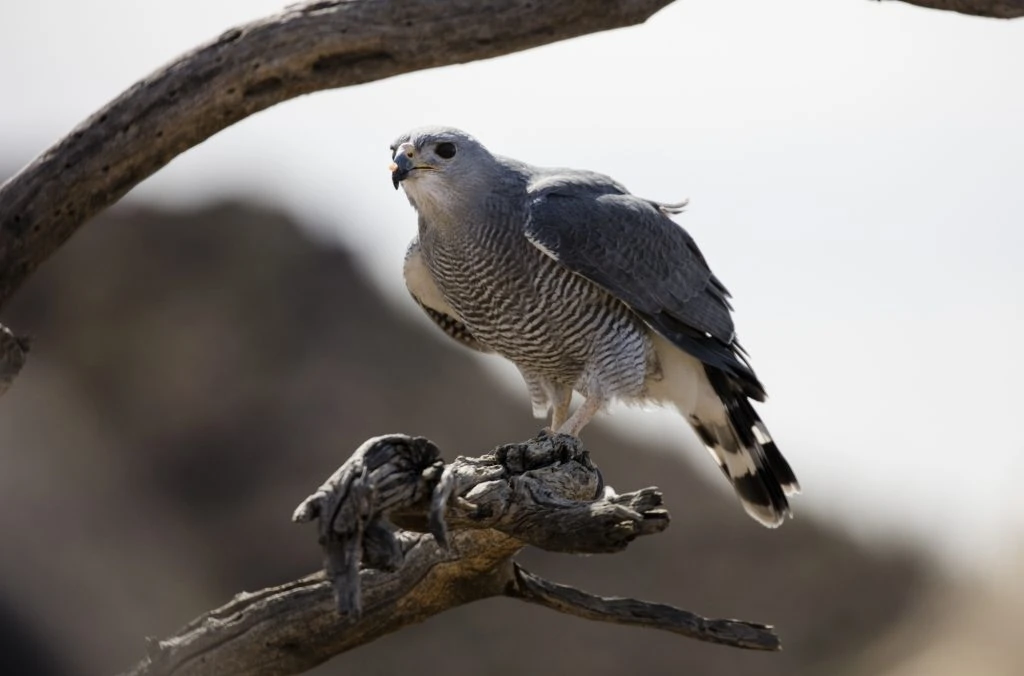
Gray Hawks are light gray in color with solid gray on the upper parts, barred on the chest and belly. Their tails are long and have three white bands against black. They have short, broad wings and are smaller hawks in this family.
- Length: 18–24 in (46–61 cm)
- Weight: 13.8-16.6 oz (391-470 g)
Gray Hawks migrate and spend the summer breeding in Central America, Mexico, and Southern Texas, and Arizona.
Try looking for Gray hawks in cottonwood and willow woods, with streams or rivers nearby. They can be spotted soaring over open areas or perched on branches waiting patiently for lizards.
12. Northern Goshawk
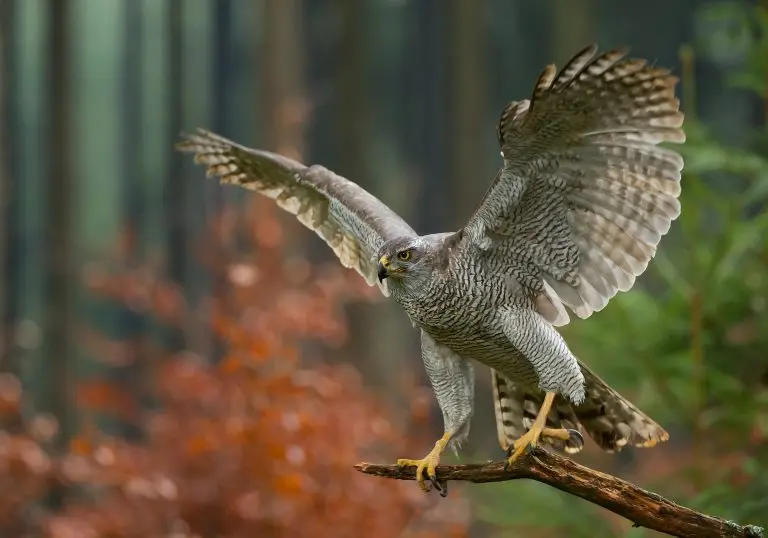
Northern Goshawk are the bigger and fiercer relative of the Sharp-shinned and Cooper’s Hawks. They are mostly gray with short, broad wings and a long tail and have a white stripe over their yellow eyes.
- Length: 20.9-25.2 in (53-64 cm)
- Weight: 22.3-48.1 oz (631-1364 g)
- Wingspan: 40.5-46.1 in (103-117 cm)
Northern Goshawks are resident in Alaska, Canada, and the mountainous west. Some younger birds may migrate to Central States during the winter.
They live in large forests, so they are hard to find, especially as they are very secretive and can be aggressive if you get too close to a nest.
Northern Goshawks live in large tracks of mostly coniferous or mixed forests. They watch for prey on high perches and mostly eat medium-sized birds and small mammals.
Northern Goshawks prepare up to eight nests and lay between 2-4 bluish-white eggs.
13. White-tailed Hawk
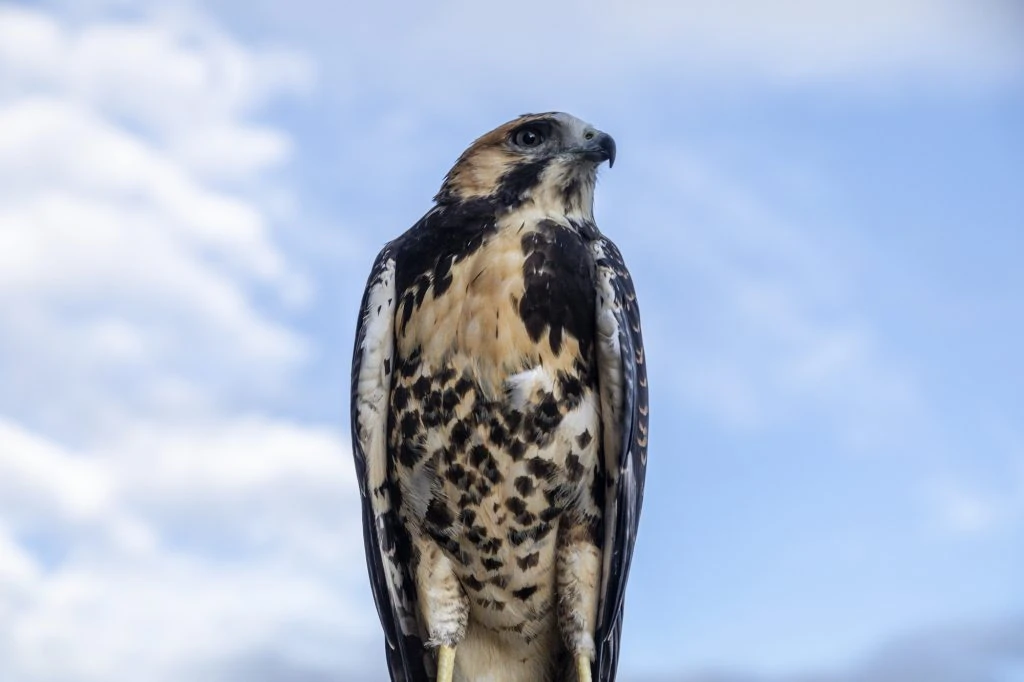
White-tailed Hawks are distinctive hawks with dark coloring on the back, with red shoulders and a flash of white underneath. Their tails also stand out, being white on the top and underneath and with a dark band running around the edge.
Immatures are speckled across the chest and belly, and some birds can be an all-dark morph. Females are larger than males.
- Male
- Length: 18.1-20.5 in (46-52 cm)
- Weight: 31.0-43.6 oz (880-1235 g)
- Wingspan: 50.4-51.6 in (128-131 cm)
- Female
- Length: 18.9-22.8 in (48-58 cm)
White-tailed Hawks do not migrate and are more common in South America, with some birds reaching up as far as Texas.
Grasslands and savannahs are the usual hunting grounds for White-tailed Hawks. Rodents, rabbits, lizards, and other birds make up their diet.
They are especially easy to spot after fires when they take advantage of the fleeing animals for a quick meal.
14. Zone-tailed hawk
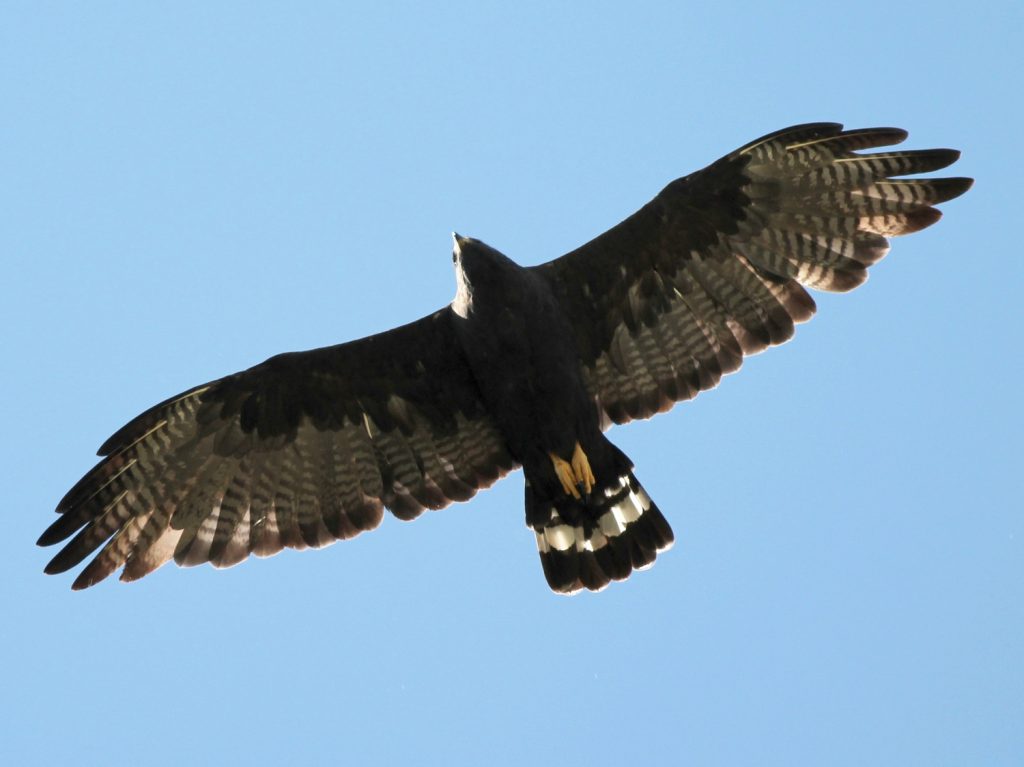
Zone-tailed Hawks are dark, almost black hawks with barring on the flight feathers’ underside and white bands across the tail.
- Male
- Length: 17.7-22.1 in (45-56 cm)
- Weight: 21.4-23.5 oz (607-667 g)
- Wingspan: 46.9-55.1 in (119-140 cm)
- Female
- Weight: 29.8-33.0 oz (845-937 g)
- Wingspan: 46.9-55.1 in (119-140 cm)
Zone-tailed Hawks are another Hawk that can only be spotted in a few states along the border during the breeding season. In winter, they migrate further south into Mexico. In South America, Zone-tailed Hawks remain all year.
They hunt along canyons and cliffs, often in high elevations, and can be spotted soaring over desert and scrub. They will also hunt down to coastal plains.
Mammals, birds, reptiles, and amphibians make up the diet of Zone-tailed Hawks. They hunt by flying low and using the landscape as a screen to hide them until it’s too late.
15. Short-tailed Hawk
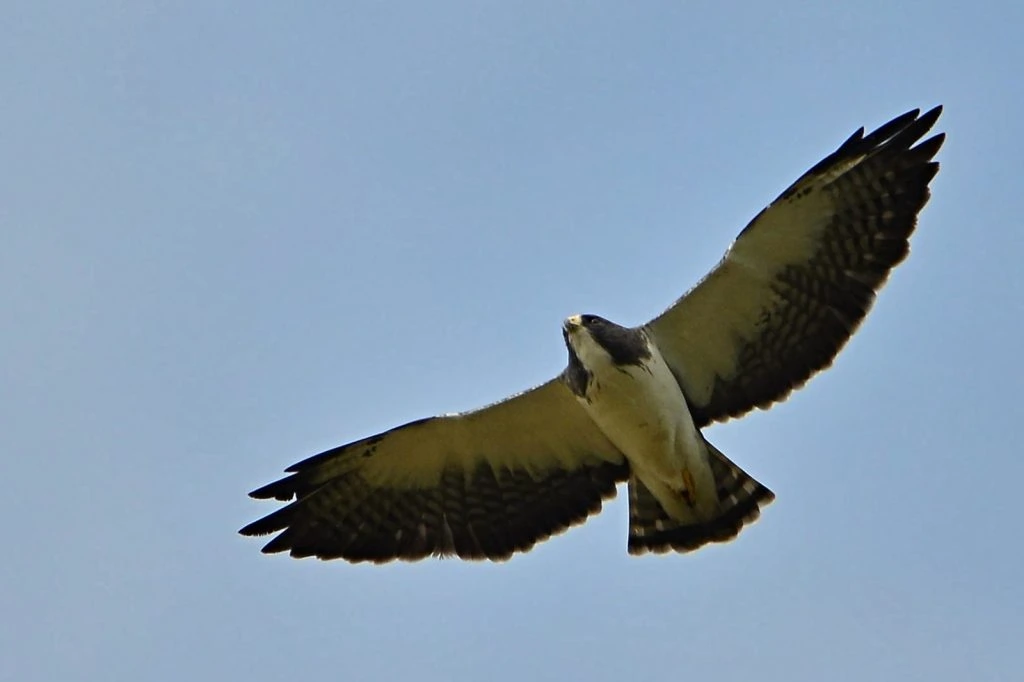
Short-tailed Hawks are small hawks that can either be light or dark in color. Dark morphs are very dark brown, but with lighter flight feathers underneath, Light morphs are white below and brown on the back. As the name would suggest, they have short tails compared to other hawks.
- Length: 15 – 17 in (38 – 43)
- Weight: 0.8 – 1.1 lb (362 – 500 g )
They live in Mexico, Central and South America, and Florida. Short-tailed Hawks can be hard to spot as they hunt small birds from high up in the sky.
16. Common Black Hawk
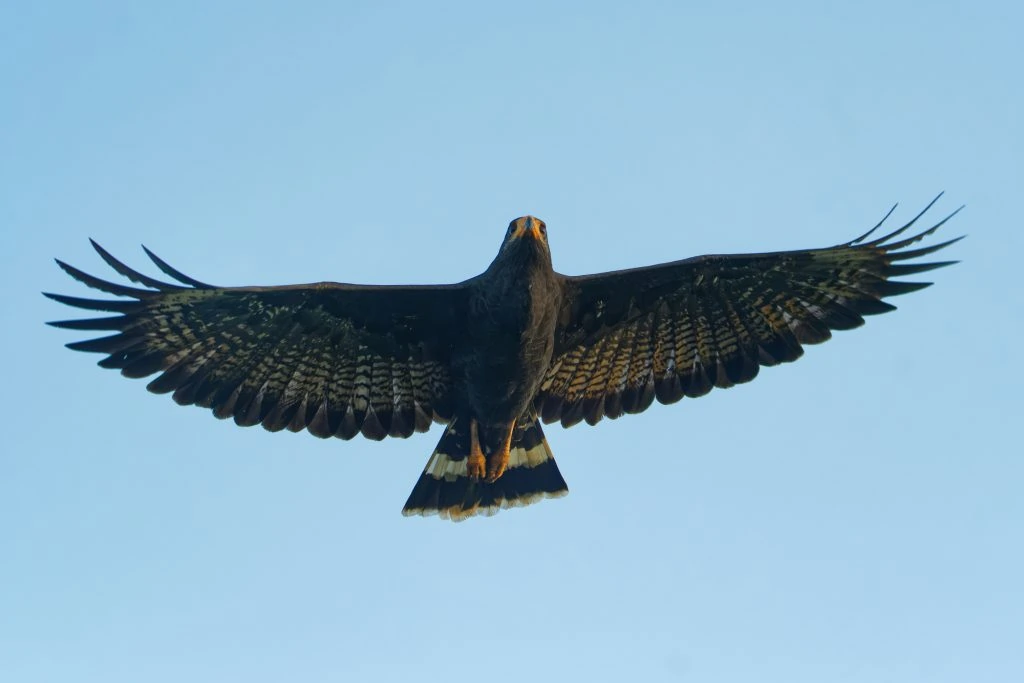
Common Black Hawks have broad wings, short tails, long legs, and large bodies. They are black, except for a white band across the tail.
- Length: 17 – 21 in (43 – 53)
- Weight: 33oz (930g)
They can be spotted along the southern border from California to Texas, mostly in summer. However, they usually remain resident all year in their range in Mexico and Central America.
Although called ‘common’, they are not very common in the United States, and only about 250 pairs are thought to exist here.
They hunt along streams near woods, looking for crabs, fish, frogs, and lizards, but they will also hunt birds and small mammals.
17. Great black Hawk
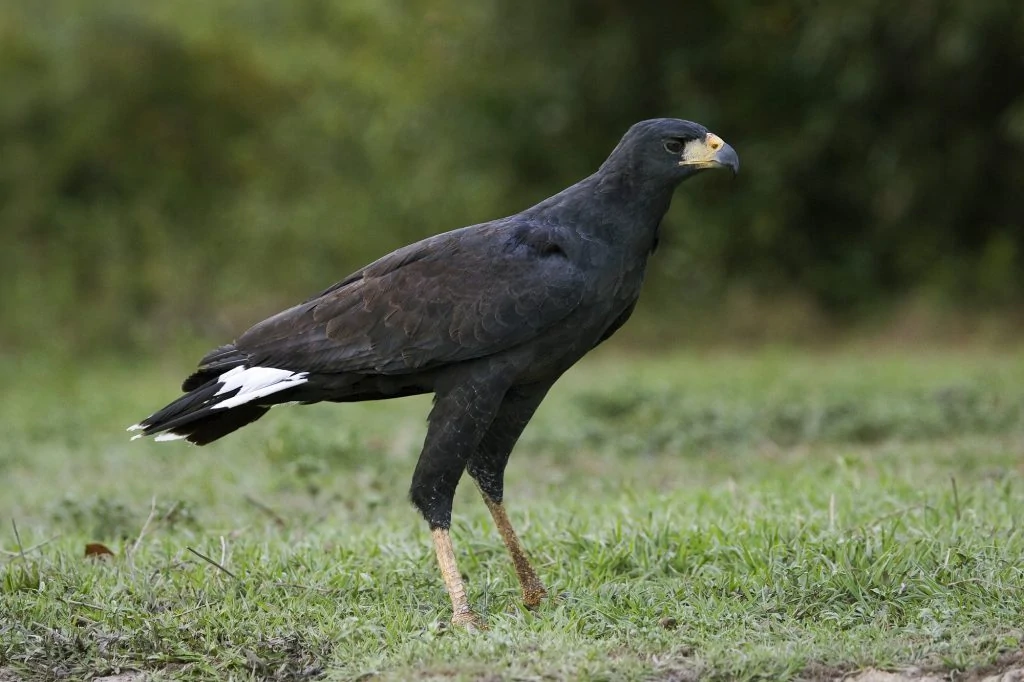
Great Black Hawks are considered rare or accidental species here, but they have been spotted in Texas and Florida in recent years.
Great Black Hawks are similar in appearance to Common Black Hawks but are larger and have two white tail bands.
- Length: 22 – 25 in (56 – 64)
- Weight: 2lb 7oz (1.2kg)
Great Black Hawks are usually resident in Central and South America, but some have flown into southern US states and Florida.
They feed on reptiles, small vertebrates, large insects, and eggs or chicks from nests.
18. Roadside Hawk
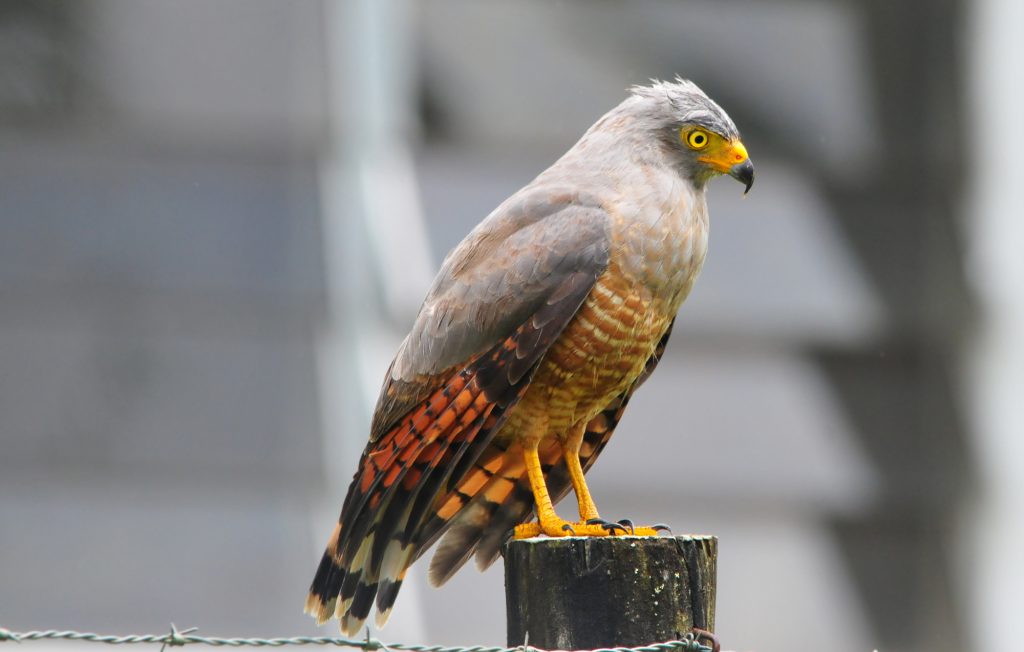
Roadside Hawks are small brown or gray birds of prey with barred bellies. Their tails also have 5 gray bars.
- Length: 12 – 16 in (31 – 41 cm)
- Weight: 8.8 – 10.6 oz (250 – 300g)
Roadside Hawks usually live in Mexico, Central America, and South America, but some have ventured as far as Southern US states.
They eat small mammals, lizards, and insects and can often be spotted on wires and posts.
19. Crane Hawk
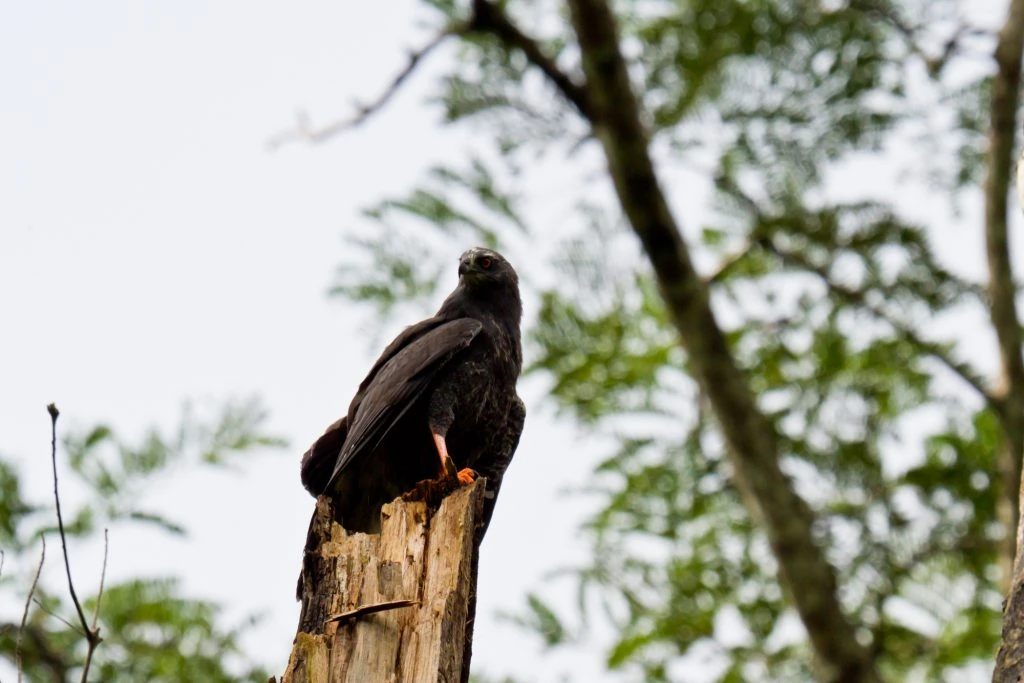
Crane Hawks are slightly odd-looking, with small heads and long legs. They can range in color from solid black to banded gray, have white stripes on their tails and have red legs.
Birds in the north of the range have red eyes, and those in the south have yellow eyes.
- Length: 15 – 21 in (38 – 54 cm)
- Weight: 8 – 18 oz (225 – 519g)
Crane Hawks are resident in Central and South America and along the coasts of Mexico. They sometimes move north into southern US states depending on conditions.
They eat small mammals, lizards, snakes, and birds and are found in wooded areas hunting in the trees for hiding spaces as they have double-jointed legs and can get in places that other birds of prey cannot.
How to Identify a Hawk
Hawks are notoriously tricky to identify because they are often soaring high up, and each species can present in different colors. However, some tips can help you to identify hawks:
- Get to know which hawks are likely to be in your area at that time of year.
- Woods or open country – Accipters, which includes Sharp-shined hawks, Cooper’s hawks and Northern Goshawks are more common in wooded areas hunting for small birds.
- Wing to tail ratio
- Accipiters have short wings and long tails to help with manourvability needed when hunting in the trees.
- Buteos, such as Red-tailed Hawks, Harris’s Hawks, Broad-winged Hawks, Red-shouldered Hawks have broad wings and short tails
- Size – Accipiters are smaller than Buteos
- Practice – hawks identification is hard but that is a great excuse to get out and do more!
Hawks that Migrate
It is easier to identify hawks if you know which ones you are likely to see at different times of the year.
Hawks in more northern areas, such as Alaska and Canada, tend to migrate south for winter, but hawks of the same species further south may remain all year.
All Broad-winged Hawks and Swainson’s Hawks migrate the furthest in large numbers down to South America.
All Rough-legged Hawks also migrate after breeding in Alaska and Canada to the US for winter.
Hawks with only some birds migrating from the north of the range, in Alaska and Canada, include Red-tailed Hawks, Red-shouldered Hawks, Cooper’s Hawks, Northern Harriers, and Sharp-shined Hawks.

